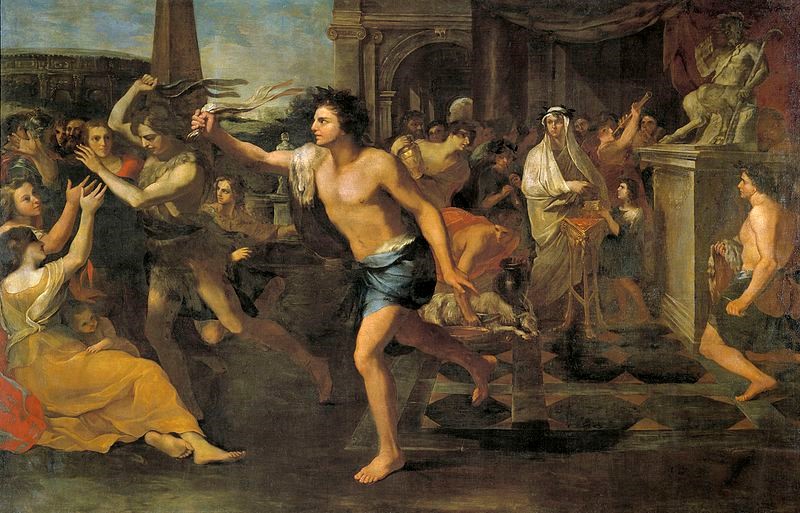I am no fan of Valentine’s Day. A simple Google search of “I hate Valentine’s Day” will prove that I am not alone in my aversion. I don’t know why I hate it. I just do. I prefer to celebrate the Ides of March, which is exactly one month and a day after Valentine’s. Give me presents on that day instead. It’s dark, interesting, and not commercialized. Perfect! However, after having done some digging, I discovered that the potential origins of Valentine’s Day are racy, macabre, and just dark enough to be interesting. Perhaps interesting enough to make me reconsider my current stance. Let’s take a look.

Like many holidays, the history of Valentine’s Day is a complicated one. While the exact origin of this love-soaked celebration is unknown, a reasonable place to start is in ancient Rome. The Romans celebrated the Feast of Lupercalia, a fertility festival, from February 13th to the 15th. The festivities began in Lupercal Cave on Palatine Hill, where one or more male goats and a dog were sacrificed by a sect of Roman priests called the Luperci. Immediately after the sacrifice, the blood-soaked knife was used to smear blood on the foreheads of two naked priests. The blood was subsequently removed with a piece of milk-soaked wool while the remainder of the priests ritually laughed. I’m not going to lie, that’s pretty creepy, but it wasn’t over yet.
Then began the feasting, which I’m certain was lit and probably included a lot of naked drunken dancing and lascivious behavior. At the conclusion of the festival the hides of the goats were cut into strips which were wielded by naked men running through the streets who indiscriminately whipped any woman within striking distance. This brings a whole new meaning to being “hit on”, now doesn’t it? While many women today don’t appreciate being hit on, some do and the same was true of Roman women. Some openly welcomed the ritual beating. The meaning of this ritual remains unclear, but it was almost certainly related to fertility. It is important to note that this was not a celebration of romantic love, and many scholars are unconvinced that there is a direct historical connection to Valentine’s Day, but history is complex and direct relationships are often hard to nail down.

Moving along…but still in Rome. There are several legends surrounding the lives and deaths of men named Valentine. One or more of them were said to be executed on February 14th, in the 3rd century A.D. The most prevalent story involves the execution of St. Valentine of Rome for the crime of marrying Christian couples and aiding Christians who were being persecuted by Claudius II. After being imprisoned and failing to convince Claudius to convert to Christianity, he was unceremoniously beaten and beheaded, giving a whole new meaning to “my bloody Valentine”. An important side note to this tragic story involves him restoring sight to the blind daughter of his judge, to whom he later penned a letter signing it, “Your Valentine”. Side note, could “Be My Valentine” be an actual threat of violence? I’m kidding of course, but think about it for a minute.
Further down the road in the 5th Century A.D., Pope Gelasius I established the Feast of Saint Valentine to honor him as a Christian martyr. It was to be celebrated on February 14th. Many believe that this was an effort to quash the more racy aspects of the pagan celebration of Luperci by combining it with a much more conservative Christian feast day. However, there is little direct evidence to support this idea. The feast was later removed from the General Roman Calendar because there was little firsthand evidence about St. Valentine’s life, other than where he was buried after his death. The trail of Valentine’s Day then leads us through the Middle Ages with Chaucer’s Parlement of Foules and the Charter of the Court of Love, a first Valentine’s poem and a description of the 14th being an annual celebration, respectively. Just as with much of history, even these connections are hotly debated among scholars. But, isn’t that what makes history fun?
*The narrator says in a slightly exasperated voice*
“I’m going to leave off here, as the modern history of Valentine’s Day isn’t up for much debate. Here’s to hoping that you learned something new. At the very least, I am betting that the next time someone asks you to “be their Valentine”, you’ll consider the offer in a completely different light. “

Photo Credit: Barbtrek
If Valentine’s Day is on your to-do list this year, keep HMNS in mind. Show your sweetheart your everlasting love by participating in our Endless Love event and naming a cockroach after them. Or if a romantic dinner with that special someone is more your speed, join us Friday, February 14, at HMNS at Sugar Land for our “Spirit” of Love dinner and lecture with mixologist Drayton Dupree. Purchase tickets here.

